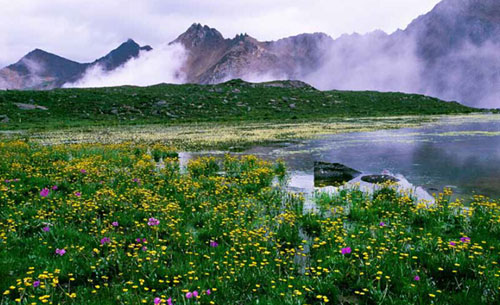 |
|
A diverse range of alpine wild flowers adds to the charm of Sichuan province in Southwest China. Photos provided to China Daily |
The vast mountain areas of Sichuan province are blessed with a diverse range of alpine wild flowers and plants. Due to the different growing environments at different altitudes, one can find broad-leaved forests, coniferous forests, alpine bosk and meadows thriving simultaneously.
Sichuan’s Siguniang and Gongga mountains boast well-preserved primeval forests with intact ecosystems.
Mount Siguniang, meaning “Four Girls Mountain” or “Four Sisters Mountain”, is the highest peak of Western China’s Qionglai Mountains. It encompasses four continuous peaks, with the main peak reaching 6,250 meters.
The mountains are home to abundant alpine wild flowers and plants.
Blossom season, which is from March to October, sees colors spread over the expanse of mountains, plains, meadows, and on the icy edges of the snow peaks.
 |
|
A variety of alpine wild flowers bloom at high altitude on Siguniang and Gongga mountains. |
There is also an amazing diversity of animal life, featuring many national first-class protected species, including the Sichuan golden monkey, whitelipped deer, clouded leopard, snow leopard and occasional giant panda. The mountains’ attractions include:
• Bipenggou Valley
Bipenggou is famous for primitive forests, lakes, waterfalls, glaciers and azaleas. Located in Li county, Aba Tibetan and Qiang autonomous prefecture of Sichuan province, the valley is blessed with primrose flowers, azalea, and red woods. It is also consider one of the best places to see fall foliage in China.
Nearby attractions include Taoping Qiang ethnic village, located in Li county. It has the world’s largest number of well-preserved buildings erected by the Qiang people. Thanks to the mountains that surround it, the village is equipped with an underground water supply system.
• Mengbi Mountain
Mengbi Mountain, located 30 kilometers from the town of Barkam, is one of the best places to see meconopsis. The genus of flowering plants in the family Papaveraceae flourish in late spring and early summer, creating a riot of color.
Barkam town is not a common tourist haunt and offers a quiet retreat for those who want to explore Gyarong Tibetan culture at their leisure. Gyarong is a traditional term that refers to the area hidden between the Qionglai and Minshan Mountains in northwestern Sichuan, as well as the group of Tibetan people that dwell there.
• Balangshan Pass
The pass, lying at an altitude of 4520 meters, between Siguniang Mountains and Wolong National Park, is blessed with a diversity of landscapes, including alpine meadows, river valleys, and alpine flowstone slope.
More than a century ago, British botanist and horticulturist Ernest Henry Wilson visited the pass and was impressed by the green poppy meconopsis integrifolia, which features silk-like petals and appears transparent in sunlight.
The nearby Wolong National Nature Reserve is the oldest, largest and best-known panda breeding center in China. The reserve is a beautiful location for both sightseeing and observation tours.
Mount Gongga, bordering the eastern edge of the Qinghai-Tibet Plateau and between Dadu River and Yalong River, is the highest mountain in Sichuan province, with the main peak reaching 7,556 meters.
• Laoyulin village in Kangding
Kangding, located between Qinghai- Tibet Plateau and the Sichuan Basin, is a key town on the ancient Tea Horse Road. To the north of the town is Laoyulin village, which is famous for its irises and orange-colored primula.
Paoma Mountain in the Kangding area offers a bird’s- eye view of the old town. On the eighth day of April in the Chinese lunar calendar, there is a traditional festival to celebrate the Buddha’s birthday, along with a horse racing event.
• Zimei Pass
Zimei Pass, at an altitude of 4,600 meters above sea level, features alpine plants and also provides perfect views of the snow-capped Mount Gongga.
Nearby attractions include Xinduqiao town, which is known as “the photographer’s corridor”, and is a highlight for many travelers. It offers stunning seasonal views, which include vivid green grassland, streams, mountains, and Tibetan houses.
• Yajiageng Pass
Yajiageng Pass on Mount Gongga is famous for its glacier valley filled with peculiar red stones, which you are unlikely to see anywhere else. In late May and June, the mountains are shrouded by blooming azalea.
Hailuogou valley lies on the east slope of Mount Gongga and features China’s largest ice waterfalls, which reach a height of 1,080 meters and are 1,100 meters wide.
• Yaha Pass
The way between Shangmuju village and Yaha Pass is rimmed with assorted alpine flowers, ranging from primulas to snow saussurea and rhododendron. Along the way, visitors can also marvel at the sprawling alpine grassland and meadows and exotic, local ethnic houses.
Perched in the west of Mount Gongga on the way between Shangmuju village and Yaha Pass, Quanhua Beach has a fountain where tourists can bathe and admire the charming soft water plants.
Contact the writer at lijing2009@chinadaily.com.cn
